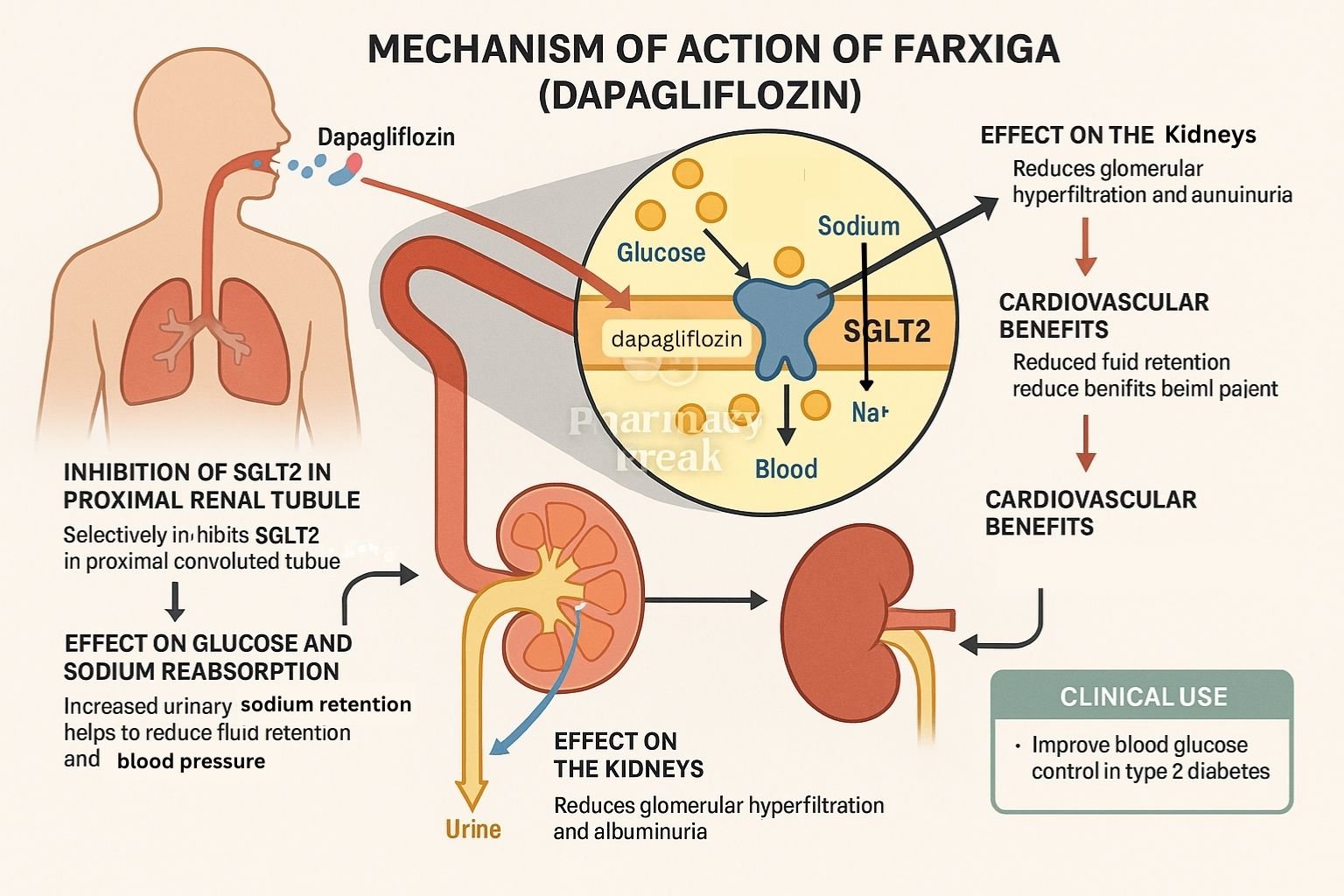Table of Contents
Introduction
Dapagliflozin (trade name Farxiga) is a sodium–glucose co‑transporter 2 (SGLT2) inhibitor used in type 2 diabetes mellitus (T2DM) and heart failure with reduced ejection fraction (HFrEF). It lowers blood glucose by promoting renal excretion of glucose and also provides cardiovascular and renal benefits beyond glycemic control.
Step-by-Step Mechanism of Action
- Selective inhibition of SGLT2 in proximal renal tubule
Dapagliflozin blocks the SGLT2 protein in the kidneys, reducing reabsorption of filtered glucose and sodium. - Increased urinary glucose excretion (UGE)
Inhibition leads to excretion of 60–80 g of glucose per day, lowering plasma glucose and HbA₁c. - Osmotic diuresis and natriuresis
Glucosuria draws water into the urine; concurrent sodium loss lowers plasma volume, blood pressure, and preload. - Weight loss and metabolic effects
Caloric loss from glucosuria leads to weight reduction. Improved insulin sensitivity and cardiovascular outcomes follow. - Renoprotective and cardioprotective actions
Mechanisms include reduced intraglomerular pressure, decreased albuminuria, and improved heart function via reduced preload, afterload, and energy utilization enhancement.
Pharmacokinetic Parameters
| Parameter | Value |
|---|---|
| Route | Oral (tablet) |
| Bioavailability | ~78% |
| Time to Peak (Tmax) | ~2 hours |
| Protein Binding | ~91% |
| Metabolism | Hepatic via UGT1A9 to inactive glucuronide |
| Half-life | ~12–13 hours |
| Excretion | ~75% renal (mostly unchanged), rest fecal |
Clinical Uses
- Glycemic control in type 2 diabetes
- Reduces risk of cardiovascular death and hospitalization in HFrEF (with or without diabetes)
- Slows progression of chronic kidney disease (CKD)
Adverse Effects
- Genitourinary infections: mycotic vaginal and urinary tract infections
- Volume depletion: hypotension, dizziness, especially in elderly or those on diuretics
- Euglycemic diabetic ketoacidosis (rare)
- Electrolyte changes: mild increases in LDL cholesterol and magnesium, possible slight potassium changes
Comparative Analysis
| Drug | SGLT selectivity | HbA₁c Reduction | Weight Loss | Cardiorenal Benefit |
|---|---|---|---|---|
| Dapagliflozin | SGLT2 > SGLT1 | 0.5–1.0% | 2–3 kg | Yes |
| Canagliflozin | SGLT2 ≈ SGLT1 | 0.8–1.1% | 2.5–3.5 kg | Yes |
| Empagliflozin | High SGLT2 | 0.7–1.0% | 2–3 kg | Yes |
MCQs (15)
- Dapagliflozin primarily inhibits which transporter?
a) SGLT1 b) SGLT2 c) GLUT4 d) Na⁺/K⁺ ATPase
Answer: b) SGLT2 - Its glucose-lowering effect is due to:
a) Enhanced insulin release b) Renal glucose excretion c) Intestinal glucose absorption blockade d) Hepatic gluconeogenesis inhibition
Answer: b) Renal glucose excretion - Usual urinary glucose loss per day is around:
a) 10 g b) 30 g c) 60–80 g d) 100 g
Answer: c) 60–80 g - Common genitourinary side effect is:
a) Pharyngitis b) Vaginal yeast infection c) Otitis media d) Dental caries
Answer: b) Vaginal yeast infection - Dapagliflozin acts on which part of the nephron?
a) Proximal tubule b) Loop of Henle c) Distal tubule d) Collecting duct
Answer: a) Proximal tubule - Its effects on blood pressure are due to:
a) Beta-blockade b) Natriuresis c) Vasodilation d) Calcium channel blockade
Answer: b) Natriuresis - Rare but serious risk is:
a) Lactic acidosis b) Euglycemic DKA c) Hyperthyroidism d) Bladder cancer
Answer: b) Euglycemic DKA - Dapagliflozin metabolism occurs via:
a) CYP3A4 b) UGT1A9 c) CYP2C9 d) Renal CYP enzymes
Answer: b) UGT1A9 - Protein binding is approximately:
a) 50% b) 70% c) 91% d) 100%
Answer: c) 91% - Weight loss is mainly due to:
a) Appetite suppression b) Glucosuria and caloric loss c) Lipid malabsorption d) Increased exercise tolerance
Answer: b) Glucosuria and caloric loss - A comparative SGLT2 inhibitor with similar benefit is:
a) Metformin b) Sitagliptin c) Empagliflozin d) Liraglutide
Answer: c) Empagliflozin - Primary route of elimination:
a) Renal unchanged b) Biliary conjugates c) Fecal d) Pulmonary exhalation
Answer: a) Renal unchanged - Dapagliflozin should be used with caution in patients with:
a) CKD stage 3‑4 b) Hypothyroidism c) Liver cirrhosis d) Gastroenteritis
Answer: a) CKD stage 3‑4 - Electrolyte change may include mild:
a) Hypomagnesemia b) Hyperkalemia c) Hypernatremia d) Hypocalcemia
Answer: a) Hypomagnesemia - Dapagliflozin also reduces:
a) LDL cholesterol b) Triglycerides c) Cardiovascular death & HF hospitalization d) Platelet aggregation
Answer: c) Cardiovascular death & HF hospitalization
FAQs
- Is dapagliflozin effective in non-diabetic heart failure?
Yes—it reduces hospitalization for HFrEF even in non-diabetic patients. - How often should renal function be monitored?
Monitor eGFR at baseline and periodically, especially in CKD patients. - Can it cause hypotension?
Yes, especially in elderly or volume-depleted individuals; monitor blood pressure. - Does it cause hypoglycemia?
Unlikely when used alone; risk increases when combined with insulin or sulfonylureas. - Is dapagliflozin safe with ACE inhibitors or ARBs?
Yes—often used together for cardiorenal protection.
References
- Goodman & Gilman’s The Pharmacological Basis of Therapeutics, 13th Edition
- KD Tripathi. Essentials of Medical Pharmacology, 8th Edition
- DrugBank: Dapagliflozin pharmacology summary
- StatPearls: SGLT2 inhibitor mechanisms and effects
- PubMed review: Cardiorenal benefits of dapagliflozin in T2DM and HF
I am pursuing MBA in pharmaceutical management from NIPER Hyderabad with a strong academic record and proven success in national-level pharmacy entrance exams. I secured AIR 61 in NIPER 2024 (MS/M.Pharm) and AIR 27 in NIPER MBA, along with AIR 147 in GPAT 2024 and AIR 907 in GPAT 2023. I also achieved AIR 6 in AIIMS CRE-2025 for Drug Store Keeper and was selected as a Pharmacist (AIR 61) for ESIC. Additionally, I was the Runner-Up in Round 2 of the EY Case Study Competition.
At PharmacyFreak.com, I aim to guide future pharmacists through expert content, exam strategies, and insightful resources based on real experience and academic excellence.
Mail- harsh@pharmacyfreak.com
